The Implications of a Co-Created Software Solution for Mobility in Rural Areas
Abstract
1. Introduction
- Dynamic real-time ride-sharing: This option automates the matching, routing, scheduling, and pricing of rides, often at short notice or on the move.
- Carpooling: Primarily for commuters with similar routes and a preference for regular carpooling to work.
- Long-distance ride-matching: For travelers on inter-city, inter-state, and inter-country journeys, allowing users to specify departure regions and times based on ride availability.
- One-Shot Ride-Match: Combines aspects of carpooling and long-distance ride-sharing, offering choices for different types of trips.
- Bulletin Board: Provides ride-share opportunities based on bulletin boards, allowing users to add desired information to offers and requests.
- Flexible carpooling: Coordinates ride-sharing on the spot, without the need for pre-arrangement [27].
2. Research Design and Objectives
2.1. Goal and Research Questions
- What specific challenges arise in the development of co-created mobility software for rural regions?
- To what extent and with what specifics are ride-sharing benches used?
- How can the use of ride-sharing benches be increased via digital solutions?
- Does involving counties in the cooperative development of software in rural areas positively impact effectiveness and user acceptance?
2.2. Method and Approach
3. Results: Finding and Analyzing a Use Case
3.1. Elaboration of the Use Case
- Ride-sharing benches are already present in both partner counties, providing an existing infrastructure to build upon.
- The use case could be replicated in other districts, making it a scalable solution.
- Digitizing the ride-sharing bench provides an opportunity to bridge digital and analog realms, promoting digital solutions at a physical location.
- The implementation of a QR code-based solution would offer a simple and user-friendly software solution to facilitate digital interactions.
3.2. Further Use Case Analysis
3.2.1. Workshops
3.2.2. Survey-Based Insights on Ride-Sharing Bench Usage in Existing Literature
3.2.3. Results from Our Conducted Survey
3.2.4. Market Research
3.2.5. Location of the Benches
3.2.6. Summary Use Case Analysis
4. Results: First Insights in the Solution
5. Discussion
6. Conclusions
Funding
Data Availability Statement
Acknowledgments
Conflicts of Interest
References and Note
- Fraunhofer IESE. Strategiepapier für Smarte Landkreise; Fraunhofer IESE: Kaiserslautern, Germany, 2021; Available online: https://www.toolset-landkreise.digital/wp-content/uploads/sites/12/2023/05/Strategiepapier-fuer-Smarte-Landkreise.pdf (accessed on 25 July 2023).
- Dubois, A.; Sielker, F. Digitalization in sparsely populated areas: Between place-based practices and the smart region agenda. Reg. Stud. 2022, 56, 1771–1782. [Google Scholar] [CrossRef]
- Stein, V.; Pentzold, C.; Peter, S.; Sterly, S. Digitalization and Civic Participation in Rural Areas. A Systematic Review of Scientific Journals, 2010–2020. RuR 2022, 80, 251–265. [Google Scholar] [CrossRef]
- Cowie, P.; Townsend, L.; Salemink, K. Smart rural futures: Will rural areas be left behind in the 4th industrial revolution? J. Rural Stud. 2020, 79, 169–176. [Google Scholar] [CrossRef] [PubMed]
- Halsbenning, S. Digitalisierung öffentlicher Dienstleistungen: Herausforderungen und Erfolgsfaktoren der OZG-Umsetzung in der Kommunalverwaltung. HMD 2021, 58, 1038–1053. [Google Scholar] [CrossRef]
- Initiative Stadt.Land.Digital. Wie Smart Sind Deutschlands Kommunen?: Studie im Auftrag des Bundesministeriums für Wirtschaft und Energie; Initiative Stadt.Land.Digital: Berlin, Germany, 2022; Available online: https://www.de.digital/DIGITAL/Redaktion/DE/Publikation/stadt-land-digital-update-digitalisierung.pdf?__blob=publicationFile&v=1 (accessed on 25 July 2023).
- Hildner, A.; Stutz, D.; Teuteberg, F. Sorgenetzwerk: Digitalisierung unterstützt rurale Versorgung. Pflegez 2018, 71, 44–47. [Google Scholar] [CrossRef][Green Version]
- Pfannstiel, M.A.; Krammer, S.; Swoboda, W. (Eds.) Digitale Transformation von Dienstleistungen im Gesundheitswesen IV; Springer Fachmedien Wiesbaden: Wiesbaden, Germany, 2018. [Google Scholar]
- Simon, R.; Garthaus, M.; Koppenburger, A.; Remmers, H. Dorfgemeinschaft 2.0—Altern und Digitalisierung im ländlichen Raum. Zur Entwicklung eines Instruments zur ethischen Fallbesprechung in der ambulanten Gesundheitsversorgung. In Digitale Transformation von Dienstleistungen im Gesundheitswesen IV; Pfannstiel, M.A., Krammer, S., Swoboda, W., Eds.; Springer Fachmedien Wiesbaden: Wiesbaden, Germany, 2018; pp. 293–315. [Google Scholar]
- Williger, B.; Wojtech, A. Digitalisierung im Ländlichen Raum: Status Quo & Chancen für Gemeinden. Available online: https://www.scs.fraunhofer.de/content/dam/scs/DE/download/studien/Digitalisierung_im_L%C3%A4ndlichen_Raum_WhitePaper_FraunhoferSCS.pdf (accessed on 25 July 2023).
- Gilroy, P.; Krimmer, H.; Priemer, J.; Kononykhina, O.; Pereira Robledo, M.; Stratenwerth-Neunzig, F. Vereinssterben in Ländlichen Regionen: Digitalisierung als Chance; Stifterverband: Berlin, Germany, 2018; Available online: https://www.ziviz.de/sites/ziv/files/vereinssterben_in_laendlichen_regionen.pdf (accessed on 25 July 2023).
- Janacek, E.; Margarian, A. Digitalisierung Sozialer Dienstleistungen in Ländlichen Regionen: Eine Analyse Feldkonfigurierender Diskurse; Johann Heinrich von Thünen-Institut: Braunschweig, Germany, 2020. [Google Scholar]
- Cardullo, P.; Di Feliciantonio, C.; Kitchin, R. The Right to the Smart City; Emerald Publishing: Bingley, UK, 2019; ISBN 978-1-78769-139-1. [Google Scholar]
- Ferrari, A.; Bacco, M.; Gaber, K.; Jedlitschka, A.; Hess, S.; Kaipainen, J.; Koltsida, P.; Toli, E.; Brunori, G. Drivers, barriers and impacts of digitalisation in rural areas from the viewpoint of experts. Inf. Softw. Technol. 2022, 145, 106816. [Google Scholar] [CrossRef]
- Bartels, N.; Koch, M.; Schmitt, A. Digitale Ökosysteme im Ländlichen Raum: Herausforderungen bei der Gestaltung eines Digitalen Ökosystems und Zugehöriger Geschäftsmodelle. Available online: https://www.informatik-aktuell.de/management-und-recht/digitalisierung/digitale-oekosysteme-im-laendlichen-raum-i.html (accessed on 9 January 2023).
- Mounce, R.; Beecroft, M.; Nelson, J.D. On the role of frameworks and smart mobility in addressing the rural mobility problem. Res. Transp. Econ. 2020, 83, 100956. [Google Scholar] [CrossRef]
- Zachäus, C.; Meyer, G. (Eds.) Intelligent System Solutions for Auto Mobility and Beyond; Springer International Publishing: Cham, Switzerland, 2021; ISBN 978-3-030-65870-0. [Google Scholar]
- BMEL. Das Land Lebt!: Dritter Bericht der Bundesregierung zur Entwicklung der Ländlichen Räume. 2022. Available online: https://www.bmel.de/SharedDocs/Downloads/DE/_laendliche-Regionen/regierungsbericht-laendliche-raeume-2020.pdf?__blob=publicationFile&v=5 (accessed on 25 July 2023).
- Nobis, C.; Kuhnimhof, T. Mobilität in Deutschland. 2019. Available online: https://www.mobilitaet-in-deutschland.de/archive/pdf/MiD2017_Ergebnisbericht.pdf (accessed on 25 July 2023).
- Schaefer, C.; Stelter, A.; Holl-Supra, S.; Weber, S.; Niehaves, B. The Acceptance and Use Behavior of Shared Mobility Services in a Rural Municipality. Smart Cities 2022, 5, 1229–1240. [Google Scholar] [CrossRef]
- Hult, Å.; Perjo, L.; Smith, G. Shared Mobility in Rural Contexts: Organizational Insights from Five Mobility-as-a-Service Pilots in Sweden. Sustainability 2021, 13, 10134. [Google Scholar] [CrossRef]
- Simonson, J.; Kelle, N.; Kausmann, C.; Karnick, N.; Arriagada, C.; Hagen, C.; Hameister, N.; Huxhold, O.; Tesch-Römer, C. Volunteering in Germany: Key Findings of the Fifth German Survey on Volunteering (FWS 2019). 2019. Available online: https://www.bmfsfj.de/resource/blob/184604/a7cd006da6aed57d6d0dfab4a38e4212/5-freiwilligensurvey-englisch-data.pdf (accessed on 25 July 2023).
- Höhne, N.; Fekete, H.; Wong, J. Klimaschutzpolitik im Deutschen Verkehrssektor Entspricht etwa 3 °C Globaler Erwärmung. 2023. Available online: https://newclimate.org/sites/default/files/2023-04/temperaturpfad_verkehr_2.pdf (accessed on 25 July 2023).
- Bokolo, A.J. Examining the Adoption of Sustainable eMobility-Sharing in Smart Communities: Diffusion of Innovation Theory Perspective. Smart Cities 2023, 6, 2057–2080. [Google Scholar] [CrossRef]
- Vega Naranjo, J.M.; Jiménez-Espada, M.; Martínez García, F.M.; González-Escobar, R.; Cortés-Pérez, J.P. Intercity Mobility Assessment Facing the Demographic Challenge: A Survey-Based Research. Int. J. Environ. Res. Public Health 2023, 20, 1163. [Google Scholar] [CrossRef] [PubMed]
- Deutsches Zentrum für Luft- und Raumfahrt e.V. Verkehr in Zahlen 2022/2023. 2022. Available online: https://bmdv.bund.de/SharedDocs/DE/Publikationen/G/verkehr-in-zahlen-2022-2023-pdf.pdf?__blob=publicationFile (accessed on 25 July 2023).
- Furuhata, M.; Dessouky, M.; Ordóñez, F.; Brunet, M.-E.; Wang, X.; Koenig, S. Ridesharing: The state-of-the-art and future directions. Transp. Res. Part B Methodol. 2013, 57, 28–46. [Google Scholar] [CrossRef]
- Alonso, A.; Monzón, A.; Aguiar, I.; Ramírez-Saiz, A. Explanatory Factors of Daily Mobility Patterns in Suburban Areas: Applications and Taxonomy of Two Metropolitan Corridors in Madrid Region. ISPRS Int. J. Geo-Inf. 2023, 12, 16. [Google Scholar] [CrossRef]
- ITF. Innovations for Better Rural Mobility. Paris. Available online: https://www.itf-oecd.org/sites/default/files/docs/innovation-rural-mobility.pdf (accessed on 25 July 2023).
- Mulley, C.; Nelson, J.D.; Ho, C.; Hensher, D.A. MaaS in a regional and rural setting: Recent experience. Transp. Policy 2023, 133, 75–85. [Google Scholar] [CrossRef]
- Amaral, A.M.; Barreto, L.; Baltazar, S.; Silva, J.P.; Gonçalves, L. Implications of Mobility as a Service (MaaS) in Urban and Rural Environments: Emerging Research and Opportunities; IGI Global, Engineering Science Reference: Hershey, PA, USA, 2020; ISBN 9781799816164. [Google Scholar]
- Porru, S.; Misso, F.E.; Pani, F.E.; Repetto, C. Smart mobility and public transport: Opportunities and challenges in rural and urban areas. J. Traffic Transp. Eng. (Engl. Ed.) 2020, 7, 88–97. [Google Scholar] [CrossRef]
- Fiorello, D.; Martino, A.; Zani, L.; Christidis, P.; Navajas-Cawood, E. Mobility Data across the EU 28 Member States: Results from an Extensive CAWI Survey. Transp. Res. Procedia 2016, 14, 1104–1113. [Google Scholar] [CrossRef]
- Richter, A.; Waidelich, L.; Kölmel, B.; Bulander, R.; Glaser, P.; Proske, M.; Brügmann, S. Digitalisation and Future Challenges in Rural Areas: An Open Innovation based Research. In Proceedings of the 16th International Conference on e-Business, Prague, Czech Republic, 26–28 July 2019; SCITEPRESS—Science and Technology Publications: Setúbal, Portugal, 2019; pp. 147–153, ISBN 978-989-758-378-0. [Google Scholar]
- Deakin, E.; Frick, K.T.; Shively, K.M. Markets for Dynamic Ridesharing? Transp. Res. Rec. 2010, 2187, 131–137. [Google Scholar] [CrossRef]
- Corazza, M.V.; Carassiti, G. Investigating Maturity Requirements to Operate Mobility as a Service: The Rome Case. Sustainability 2021, 13, 8367. [Google Scholar] [CrossRef]
- Bosworth, G.; Price, L.; Collison, M.; Fox, C. Unequal futures of rural mobility: Challenges for a “Smart Countryside”. Local Econ. 2020, 35, 586–608. [Google Scholar] [CrossRef]
- Linis Neugebauer. Mitfahrbank. Picture. 2023. Available online: https://qimby.net/LinusNeugebauer (accessed on 30 August 2023).
- Renner, N. Mitfahrbänke als Mobilitätskonzept in Ländlichen Regionen: Eine Analyse von Best Practise Beispielen. Master’s Thesis, Technische Universität Kaiserslautern, Kaiserslautern, Germany, 2020. [Google Scholar]
- Thünen-Institut Forschungsbereich Ländliche Räume. Available online: https://karten.landatlas.de/ (accessed on 30 August 2023).
- Fadic, M.; Garcilazo, J.E.; Monroy, A.M.; Veneri, P. OECD Regional Development Working Papers; OECD: Paris, France, 2019. [Google Scholar]
- Potsdam Mittelmark. Vollantrag Smarte.Land.Regionen; Potsdam Mittelmark: Werder, Germany, 2020. [Google Scholar]
- Bernkastel Wittlich. Vollantrag Smarte.Land.Regionen; Bernkastel Wittlich: Wittlich, Germany, 2020. [Google Scholar]
- Blees, V.; Becker, J.; Freyer, L.; Löw, G. Erfolgsfaktor Mitfahrbank?!: Wissenschaftliche Untersuchung der Akzeptanz und des Nutzens von Mitfahrbänken. 2019. Available online: https://www.frankfurt-university.de/fileadmin/standard/Hochschule/Fachbereich_1/FFin/Neue_Mobilitaet/Veroeffentlichungen/2020/Schlussbericht_Mitfahrbaenke_19-12-09.pdf (accessed on 25 July 2023).
- B.A.U.M. ConsultGmbH. Umfrageauswertung Mitfahrbänke: Im Landkreis Ebersberg und der Region. 2021. Available online: https://www.energieagentur-ebe-m.de/data/dokumente/sonstige/2021-07-14_Umfrageauswertung_Mitfahrbnke.pdf (accessed on 25 July 2023).
- Wolfrum, L. “Lift-Sharing Benches” as Additional Low-Threshold Mobility Service for Rural Areas: An Evaluation of Their Use in Selected Communities in Lower Austria and Recommendations for Actions. Master’s Thesis, Universität Graz, Graz, Austria, 2021. [Google Scholar]
- Holzapfel, D. Wie Die Mitfahrbank zum Exportschlager der Eifel Wurde. Spiegel. 25 April 2023. Available online: https://www.spiegel.de/auto/wie-die-mitfahrerbank-zum-exportschlager-der-eifel-wurde-a-9a61f287-2dd6-4925-b2fb-a5dc8bcc7999 (accessed on 26 July 2023).
- Mitfahrverband e.V. Mitfahrportale. Available online: https://mitfahrverband.org/projekte/mitfahrportale/ (accessed on 26 July 2023).
- Statistisches Bundesamt. Press Release No. 356 of 13 September 2019; Statistisches Bundesamt: Wiesbaden, Germany, 2019.
- FELGO Gmbh. Mitfahrbänke; FELGO Gmbh: Vienna, Austria, 2021. [Google Scholar]
- Boben op Klima- und Energiewende e.V. Available online: https://www.bobenop.de/images/Downloads/BO-Praesentation-03-2022.pdf (accessed on 26 July 2023).
- DevLabor. App-Durch-Die-Eifel; Eifelkreis: Eifelkreis Bitburg-Prüm, Germany, 2023. [Google Scholar]
- Borens, S. Vorstellung App Durch Die Eifel, Berlin, Germany. 7 July 2023. [Google Scholar]
- Fraunhofer FIT. Mitfahrzentralen Erschweren das Finden Passender Mitfahrgelegenheiten durch Unnötig Minimalistische Funktionalität! 2022. Available online: https://www.fit.fraunhofer.de/content/dam/fit/de/documents/easy2use%20Studie-Mitfahrzentralen-2022.pdf (accessed on 25 July 2023).
- Hennemann, A. Gartenbauverein Oberleiterbach, Oberleiterbach, Germany. WhatsApp Gruppe Mitfahrbank; Personal communication. 2023. [Google Scholar]
- Kubik, A. The Use of Artificial Intelligence in the Assessment of User Routes in Shared Mobility Systems in Smart Cities. Smart Cities 2023, 6, 1858–1878. [Google Scholar] [CrossRef]
- Goulding, R.; Kamargianni, M. The Mobility as a Service Maturity Index: Preparing the Cities for the Mobility as a Service Era. In Proceedings of the 7th Transport Research Arena TRA 2018, Vienna, Austria, 16–19 April 2018. [Google Scholar]
- Hauptstadt TV. Die Mitfahrbank. 2023. Available online: https://www.hauptstadt.tv/sendeformate/130/Zuhause_in_Brandenburg/8012/Zuhause_in_Brandenburg_Die_Mitfahrbank.html (accessed on 26 July 2023).
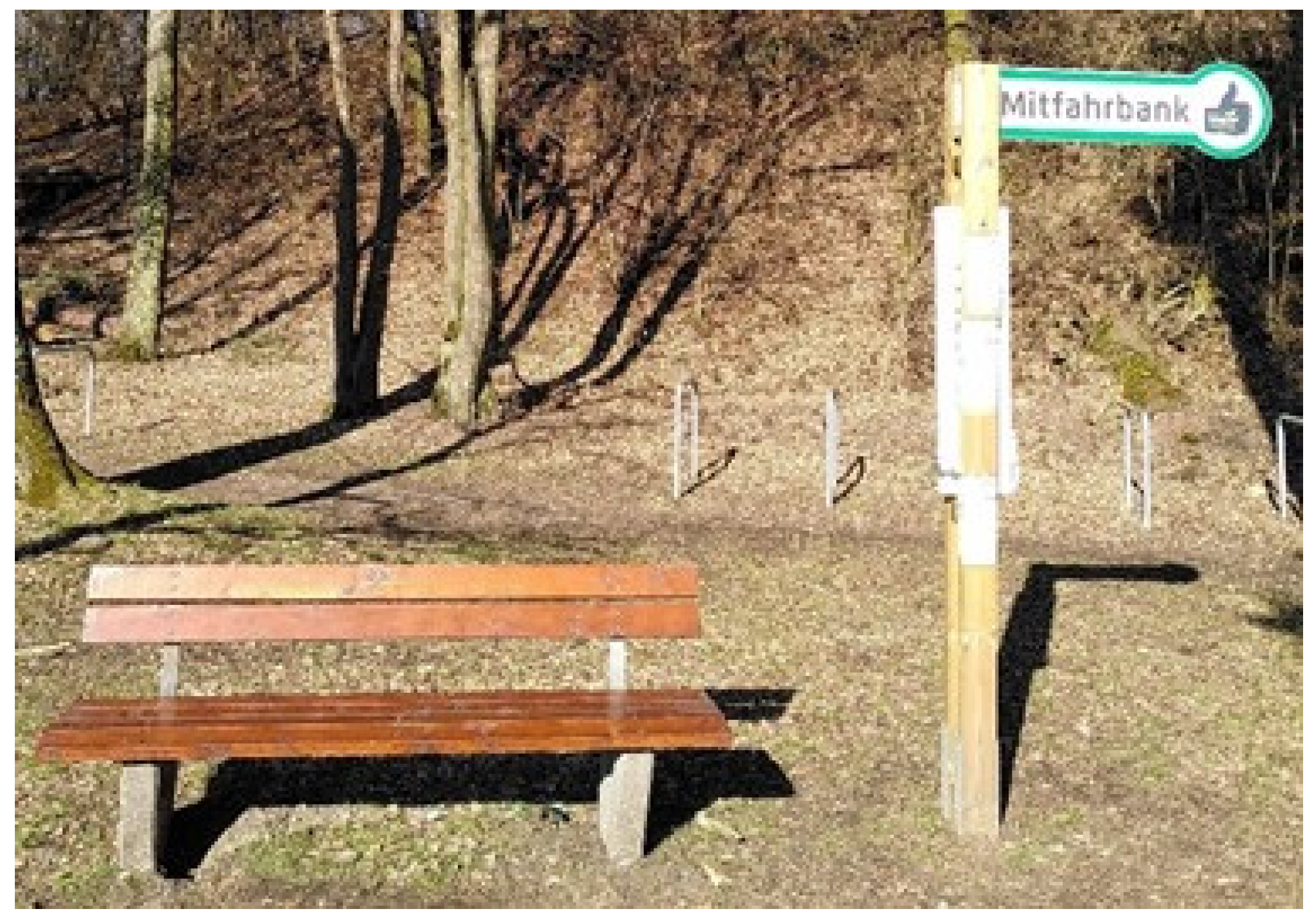
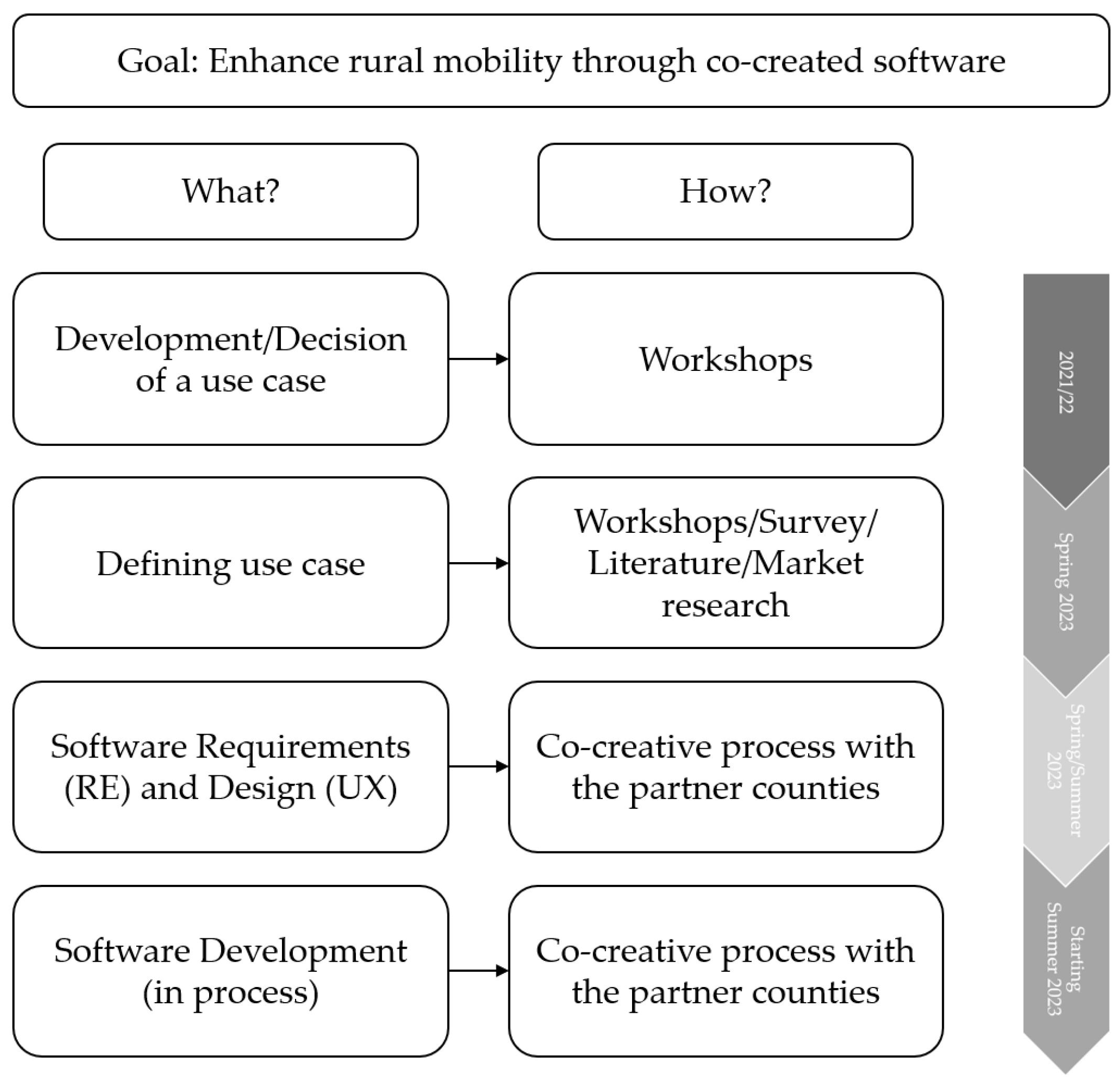
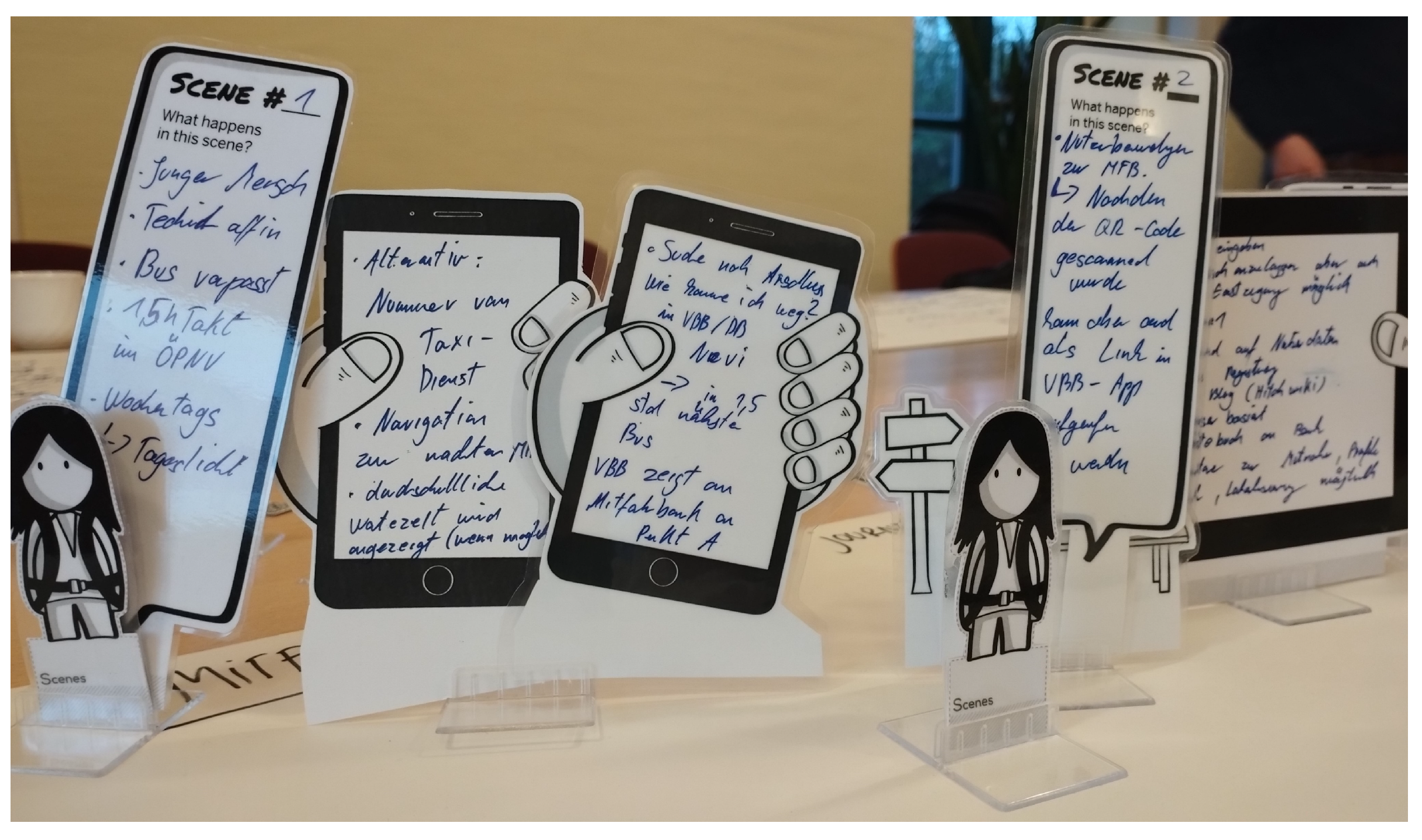

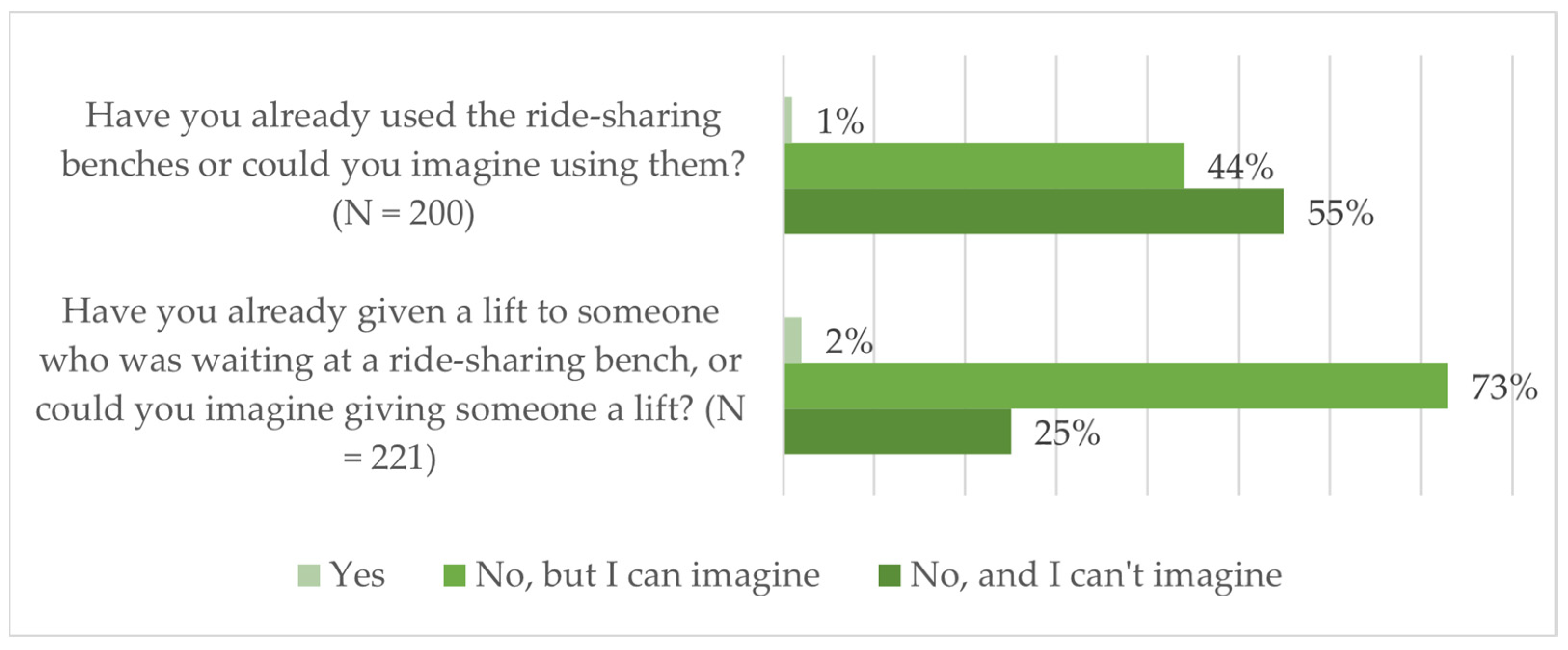
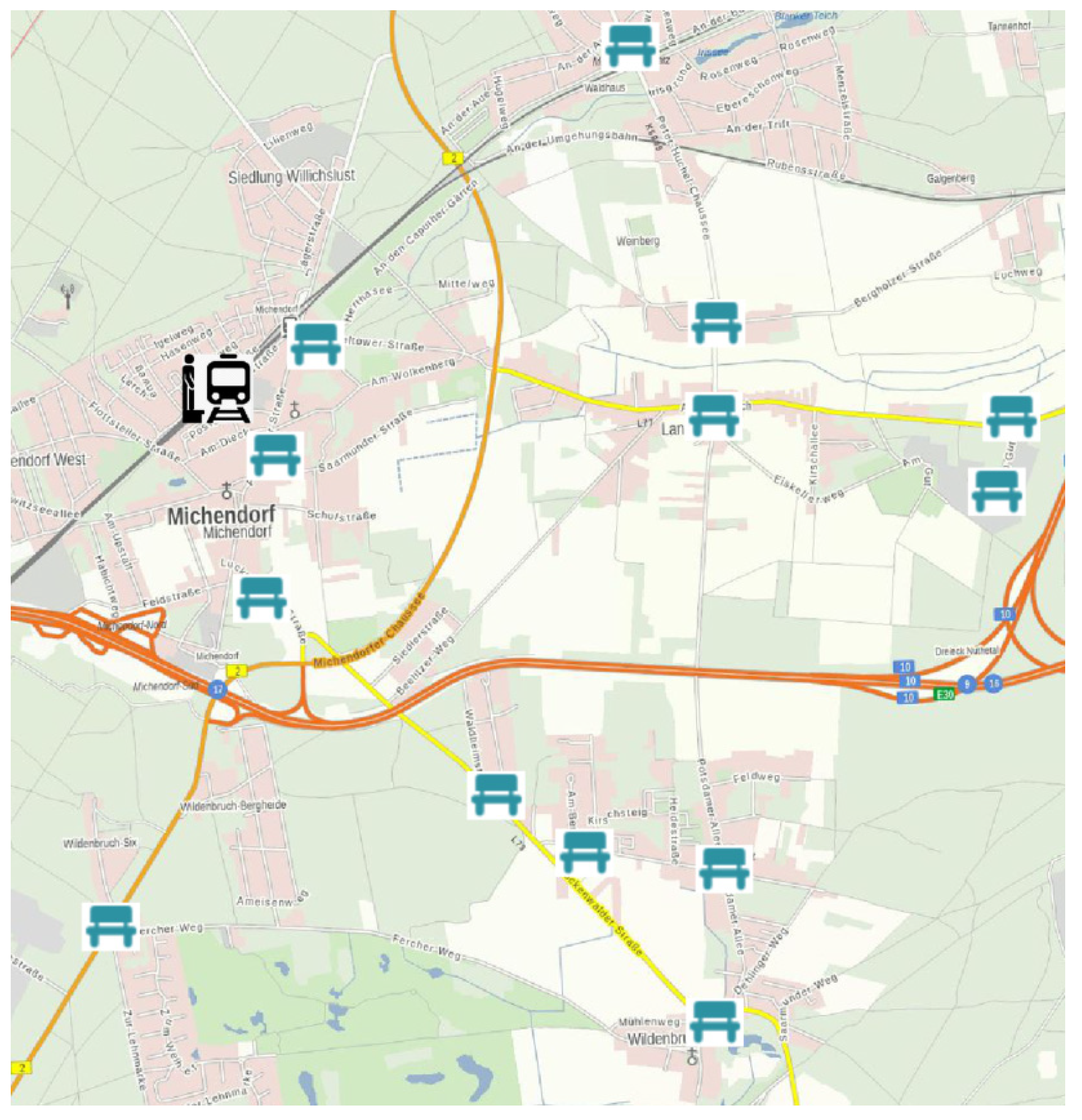
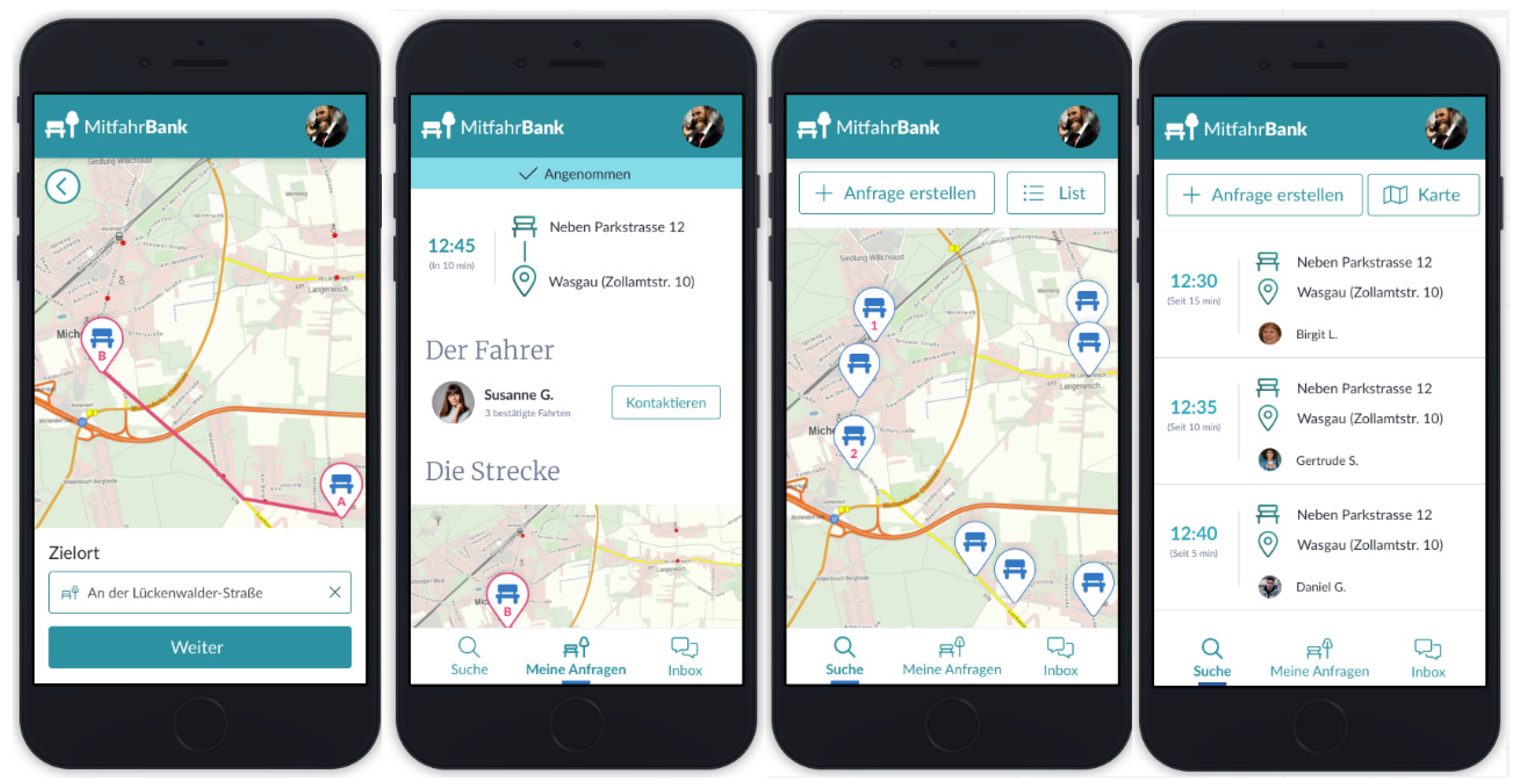
| Municipality | Population | Thünen Index | Inhabitants per Sqm |
|---|---|---|---|
| Potsdam-Mittelmark | 214,000 | 0.18 | 79 |
| Bernkastel-Wittlich | 112,000 | 0.96 | 93 |
| Title | Description |
|---|---|
| Safety concerns | Most of the participants expressed safety concerns as a primary reason for not utilizing ride-sharing benches. These concerns included a reluctance to ride with strangers and fear of criminal activity. |
| Reliability and uncertainty in usage | Some participants mentioned concerns regarding the reliability and uncertainty associated with using ride-sharing benches. |
| Lack of need or existing alternatives | A few participants stated that they did not perceive a need for ride-sharing benches or already had alternative transportation options available to them. |
| Title | Description |
|---|---|
| Absence of ride-sharing benches | Many participants mentioned the lack of available ride-sharing benches in their area as a significant barrier. |
| Ownership of personal vehicles and preferred transportation method | Some participants indicated that they had their own cars and preferred individual transportation methods, which discouraged them from using ride-sharing benches. |
| Uncertainty regarding return trips or reliability of ride offers | Some participants expressed concerns about the uncertainty surrounding return trips or the reliability of ride offers. |
| Component | Description |
|---|---|
| Browser-based solution with quick access | Users can access the platform directly via their web browsers, eliminating the need for additional app installations or complex setup processes. This approach ensures easy and widespread accessibility. |
| Map-based overview of benches and ride requests | The platform presents a visual map that displays the locations of the ride-sharing benches as well as available ride requests. This map-based overview enhances the visibility and understanding of the available options for both drivers and passengers. |
| Profile to step out of anonymity | Users have the option to create profiles, which allows them to provide relevant information about themselves and their preferences. This step encourages transparency and trust among participants, fostering a sense of social connection within the carpooling community. |
| Two levels of verification | Users must verify their mobile phone number, ensuring valid contact information. Additionally, the municipality conducts a verification process to enhance trust and security. Even without completing the second level of verification, users can access essential information such as available rides and current bench occupancy. |
| Pre-registration view | This view is specifically designed to encourage users to register by showing basic information about rides without revealing personal information about the user. |
Disclaimer/Publisher’s Note: The statements, opinions and data contained in all publications are solely those of the individual author(s) and contributor(s) and not of MDPI and/or the editor(s). MDPI and/or the editor(s) disclaim responsibility for any injury to people or property resulting from any ideas, methods, instructions or products referred to in the content. |
© 2023 by the author. Licensee MDPI, Basel, Switzerland. This article is an open access article distributed under the terms and conditions of the Creative Commons Attribution (CC BY) license (https://creativecommons.org/licenses/by/4.0/).
Share and Cite
Eichholz, L. The Implications of a Co-Created Software Solution for Mobility in Rural Areas. Smart Cities 2023, 6, 2706-2721. https://doi.org/10.3390/smartcities6050122
Eichholz L. The Implications of a Co-Created Software Solution for Mobility in Rural Areas. Smart Cities. 2023; 6(5):2706-2721. https://doi.org/10.3390/smartcities6050122
Chicago/Turabian StyleEichholz, Lutz. 2023. "The Implications of a Co-Created Software Solution for Mobility in Rural Areas" Smart Cities 6, no. 5: 2706-2721. https://doi.org/10.3390/smartcities6050122
APA StyleEichholz, L. (2023). The Implications of a Co-Created Software Solution for Mobility in Rural Areas. Smart Cities, 6(5), 2706-2721. https://doi.org/10.3390/smartcities6050122





